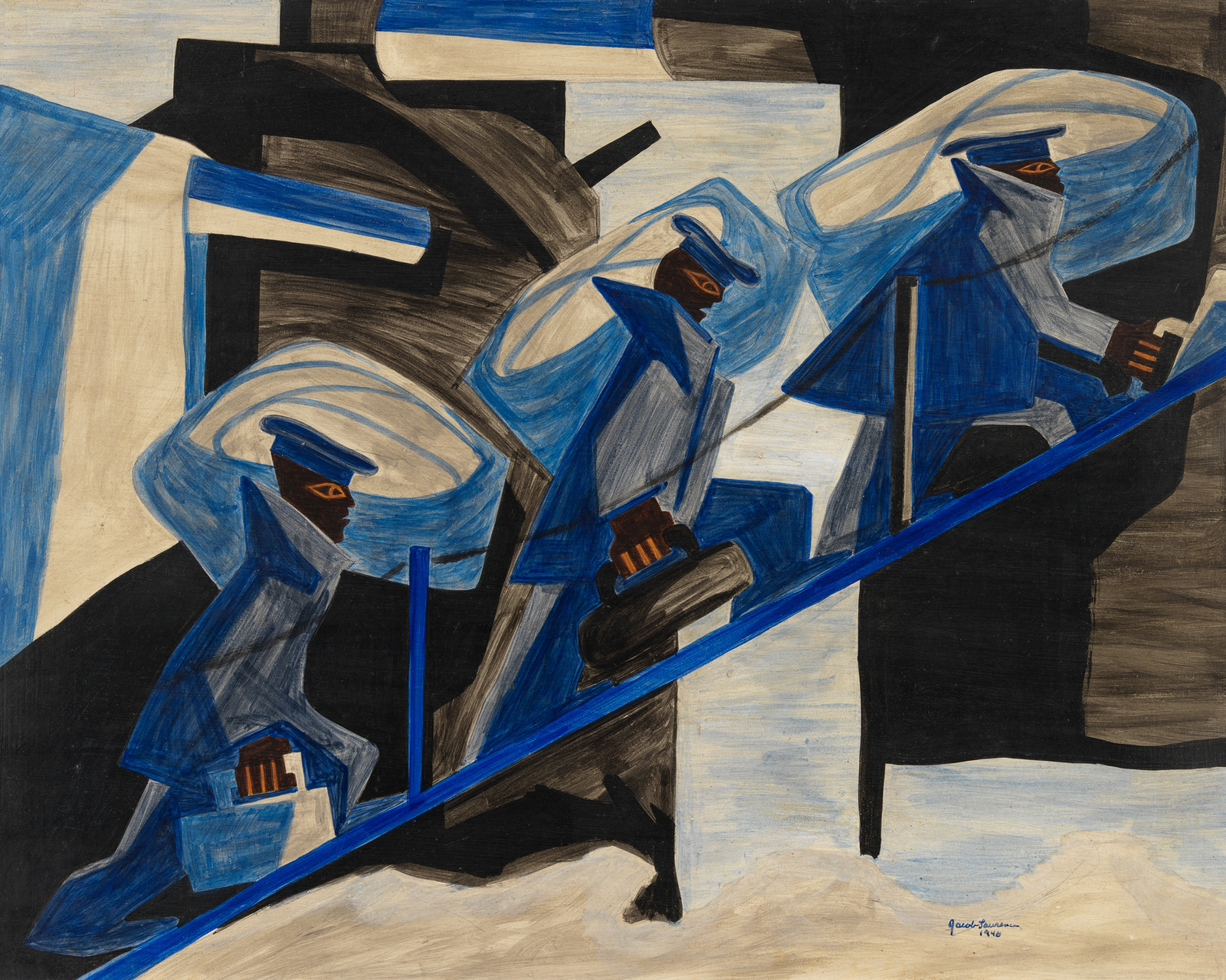Jacob Lawrence’s War Series describes first-hand the sense of regimentation, community, and displacement that the artist experienced during his service in the United States Coast Guard during World War II. Lawrence served his first year in St. Augustine, Florida, in a racially segregated regiment where he was first given the rank of Steward’s Mate, the only one available to black Americans at the time. He befriended a commander who shared his interest in art, however, and he went on to serve in an integrated regiment as Coast Guard Artist, documenting the war in Italy, England, Egypt, and India. Those works are lost, but in 1946 he received a Guggenheim Fellowship to paint the War Series. The fourteen panels of the series present a narrative which progresses from Shipping Out to Victory. In the panels, Lawrence adopted the silhouetted figures, prominent eyes, and simplified, overlapping profiles that are typical of Egyptian wall painting. And like the ancient painters, he transformed groups of figures into surface patterns, eschewing modeling and perspective in favor of the immediacy of bold, abstracted forms. In their alternation between vertical and horizontal formats, single figures and groups, and intense action and contemplation, the fourteen panels of the War Series testify to Lawrence’s belief that one cannot “tell a story in a single painting.”
Not on view
Date
1946
Classification
Paintings
Medium
Tempera on composition board
Dimensions
Overall: 16 1/8 × 20 1/4in. (41 × 51.4 cm) Image: 15 7/8 × 20 × 1/8in. (40.3 × 50.8 × 0.3 cm)
Accession number
51.8
Series
War Series
Credit line
Whitney Museum of American Art, New York; gift of Mr. and Mrs. Roy R. Neuberger
Rights and reproductions
© The Jacob and Gwendolyn Lawrence Foundation, Seattle / Artists Rights Society (ARS), New York
Audio
-
0:00
Jacob Lawrence, War Series, 1946–47
0:00
Narrator: Lawrence’s War Series originated during his service on a World War II navy transport ship.
Jacob Lawrence: I served on the USS Sea Cloud, which was a weather patrol ship, and I served on the United States Richardson, which was a troop transport. Again, I will never forget that experience. We would go over carrying 5,000 troops—young, American troops—and we would come back a hospital ship. Many of these cases were horrible. They were terrible to see, what can happen in war, especially what can happen to a person mentally, physically, psychologically. I don’t think I can verbalize that, because I would only cheapen the experience.
Narrator: Lawrence was initially given the rank of Steward’s Mate, a post that was often the only one available to African Americans. He soon rose to serve in an integrated regiment as a Coast Guard Artist, going on to document the war in Italy, England, Egypt, and India. After the war, Lawrence became an influential teacher and completed numerous public works and illustrations in addition to his painted works.
-
0:00
Jacob Lawrence, War Series, 1946–47
0:00
Mark Joshua Epstein: So we are sitting in front of a series of paintings called the War Series by an artist named Jacob Lawrence. And we're going to concentrate on one called The Letter. Take a moment to find it. What do you notice about this painting?
Student 1: I think it’s almost like the letter has done something to her. Like it was very bad news and she’s very upset about it.
Student 2: Also the colors are very dark. And their head is very low down and sad.
Student 3: Maybe she lost her husband or something because I see a ring on her finger.
Mark Joshua Epstein: It's interesting that a lot of you identified it as maybe it's a man or maybe it's a woman. It's often written about that it's a man but you're bringing up the point that it's actually kind of hard to tell because someone was just saying that we don't see the face. So when I say the title of the series, which is the War Series, do you think of paintings that look like this, that look like The Letter, or do other kinds of images come to mind?
Student 1: Usually other kinds of images. Like maybe a hospital or something, where people that have been affected by the war, like hurt, go.
Student 2: I’ve seen some paintings of ancient wars, of a bunch of soldiers with spears and riding on horses. If I was going to just hear the name I’d probably think of something like that.
Student 3: I normally think of men fighting in wars. I don't normally think of the people back at home.
Mark Joshua Epstein: Jacob Lawrence made this series in 1946 and 1947, which is right after he actually served in World War II in the Coast Guard, and he served first in an all-black regiment, and it was kind of lower down the totem pole of what one could do in the army or in the coast guard, and then later he served in an integrated regiment. He had experience of being in the war and he had experience of being all over the world. And someone mentioned before that you were thinking—maybe we think about ancient war scenes and people with spears, and people have said that Jacob Lawrence was inspired in part by the time he spent in Egypt in the Coast Guard where he would have seen these more ancient works of art.
-
Jacob Lawrence, War Series, 1946–47
In Where We Are (Spanish)
0:00
Jacob Lawrence, War Series, 1946–47
0:00
Narrator: El artista Jacob Lawrence dio el título de Victory a esta pintura al temple. Sin embargo, la cabeza de la figura pende sobre su arma asentada de pie. La pintura forma parte de War Series, que se originó durante el servicio de Lawrence en un barco de transporte de la armada, en la Segunda Guerra Mundial.
Jacob Lawrence: Serví en el USS Sea Cloud, que era un barco patrulla de clima; también serví en el United States Richardson, que transportaba tropas. Jamás olvidaré esa experiencia. En el viaje de ida transportábamos a 5,000 tropas —jóvenes soldados estadounidenses— y regresábamos convertidos en un barco-hospital. Muchos de esos casos eran horrorosos. Era terrible verlos, ver lo que podía suceder en la guerra, especialmente lo que podía sucederle a las personas mental, física y psicológicamente. No puedo verbalizarlo, porque desvalorizaría la experiencia.
Narrator: Al principio, Lawrence recibió el rango de Auxiliar de Sobrecargo, puesto que solía ser el único disponible para los afroamericanos. Pronto pasó a servir en un regimiento integrado como Artista Guarda Costa, cargo con el que pasaría a documentar la guerra en Italia, Inglaterra, Egipto e India. Después de la guerra, Lawrence se convirtió en un maestro influyente y realizó numerosas obras públicas e ilustraciones, además de su obra pictórica.
-
Jacob Lawrence, War Series, 1946–47
In Where We Are (Kids, Spanish)
0:00
Jacob Lawrence, War Series, 1946–47
0:00
Mark Joshua Epstein: Pues nos encontramos frente a una serie de pinturas denominada la War Series realizada por un artista llamado Jacob Lawrence, y nos vamos a concentrar en una obra titulada The Letter. Tómense unos instantes para encontrarla. ¿Qué les llama la atención sobre esta pintura?
Estudiante 1: Creo que es casi como que la carta le hubiera hecho algo a ella. Como si fueran muy malas noticias y ella se hubiera puesto muy triste.
Estudiante 2: También los colores son muy oscuros. Y tiene la cabeza baja, parece triste.
Estudiante 1: A lo mejor perdió a su marido o algo así, porque lleva un anillo en el dedo.
Mark Joshua Epstein: Es interesante que muchos de ustedes hayan pensado que quizás sea un hombre o una mujer. Se ha escrito normalmente que es un hombre, pero ustedes están trayendo a colación el tema de que, en realidad, es algo difícil de saber. Como alguien decía antes, no podemos ver su rostro. Entonces, cuando menciono el título de la serie, que es la War Series, ¿se imaginan pinturas como esta, como The Letter, o les vienen a la cabeza otro tipo de imágenes?
Estudiante 1: Normalmente otro tipo de imágenes. Quizás de un hospital o algo así, donde haya gente que ha sido afectada por la guerra, que tenga heridas, por ejemplo.
Estudiante 2: Yo he visto pinturas de guerras antiguas, con un montón de soldados con lanzas y a caballo. Si solo me dijeran el nombre, probablemente pensaría en algo como eso.
Estudiante 1: Yo suelo pensar en hombres luchando en una guerra. No suelo pensar en la gente que se quedó en casa.
Mark Joshua Epstein: Jacob Lawrence realizó esta serie entre 1946 y 1947, justo después de luchar en la Segunda Guerra Mundial en la Guardia Costera. En principio, sirvió en un regimiento exclusivo para negros, que era de alguna manera lo que menos rango tenía en el ejército o la guardia costera, y más tarde sirvió en un regimiento interracial. Vivió la experiencia de estar en la guerra y de viajar por todo el mundo. Y alguien mencionó antes que se le venían a la cabeza quizás escenas de guerras antiguas y de gente con lanzas, y se ha dicho que Jacob Lawrence se inspiró en parte en la época que pasó en Egipto en la Guardia Costera, donde habría visto estas obras de arte más antiguas.
-
0:00
Jacob Lawrence, War Series, 1946–47
0:00
Narrator: In War Series, Jacob Lawrence walks us through the traumatic experience of World War II.
Take a close look at the paintings, one by one. Notice the repetitive shapes and colors. Some emphasize the chaotic conditions of life in battle. Others, the cramped, confined conditions soldiers suffered off the field.
Find a group of soldiers clustered underneath a tank. Notice which directions each of the men are looking. The ones near the top seem focused on the battle ahead—but at the bottom, a wounded soldier is being carried away on a stretcher. What’s the body language like here? There’s an intense mix of stress, pain, and probably fear.
Now look at a person leaning over a black table, and looking at a single bright white sheet of paper. The painting is called The Letter. What kind of news do you think it’s delivering? And what clues does Lawrence give you about its recipients’ feelings?
Finally, let’s look at the last painting. It’s called Victory. It shows a single soldier, his head bent. You can’t see his face, but his body helps to communicate his emotions. The war is won—how would you expect him to feel? Is that how he actually looks? What kinds of words would you use to describe him? Excited? Thankful? Tired?
During the war, Lawrence served in the Coast Guard, which was then part of the Navy. Soon after it was over, he made these paintings in order to deal with his feelings about it.
-
Jacob Lawrence, War Series, 1946–47
In Where We Are (Spanish)
0:00
Jacob Lawrence, War Series, 1946–47
0:00
Narrator: El artista Jacob Lawrence dio el título de Victory a esta pintura al temple. Sin embargo, la cabeza de la figura pende sobre su arma asentada de pie. La pintura forma parte de War Series, que se originó durante el servicio de Lawrence en un barco de transporte de la armada, en la Segunda Guerra Mundial.
Jacob Lawrence: Serví en el USS Sea Cloud, que era un barco patrulla de clima; también serví en el United States Richardson, que transportaba tropas. Jamás olvidaré esa experiencia. En el viaje de ida transportábamos a 5,000 tropas —jóvenes soldados estadounidenses— y regresábamos convertidos en un barco-hospital. Muchos de esos casos eran horrorosos. Era terrible verlos, ver lo que podía suceder en la guerra, especialmente lo que podía sucederle a las personas mental, física y psicológicamente. No puedo verbalizarlo, porque desvalorizaría la experiencia.
Narrator: Al principio, Lawrence recibió el rango de Auxiliar de Sobrecargo, puesto que solía ser el único disponible para los afroamericanos. Pronto pasó a servir en un regimiento integrado como Artista Guarda Costa, cargo con el que pasaría a documentar la guerra en Italia, Inglaterra, Egipto e India. Después de la guerra, Lawrence se convirtió en un maestro influyente y realizó numerosas obras públicas e ilustraciones, además de su obra pictórica.
-
0:00
Jacob Lawrence, War Series, 1946–47
0:00
Narrator: Artist Jacob Lawrence.
Jacob Lawrence: This is owned by the Whitney Museum of American Art—it’s the War Series. There are 14 paintings in the series, and these are several of those paintings.
Narrator: Lawrence’s War Series originated during his service on a World War Two navy transport ship. It depicts a range of emotional experiences, from the fear and confusion of combat to the tragedy of loss. Lawrence made a point of showing black and white servicemen together. This reflects part of his experience in World War II. He served with the US Coast Guard, which was then part of the navy.
Jacob Lawrence: I served on the USS Sea Cloud, which was a weather patrol ship, and I served on the United States Richardson, which was a troop transport.
Narrator: Like most African American sailors, Lawrence was initially classified as a steward’s mate—essentially, a servant for white officers. But his first captain, Lieutenant Commander Carlton Skinner, made his ship, the Sea Cloud the first fully integrated vessel in the US Navy. Captain Skinner helped Lawrence obtain a public relations rating. This allowed him to paint on duty, as ship’s artist.
Lawrence began the War Series soon after he was discharged in December, 1945. It was his way of coming to terms with what he’d witnessed. If you’d like to hear more about his experience, tap the button to continue.
Exhibitions
-
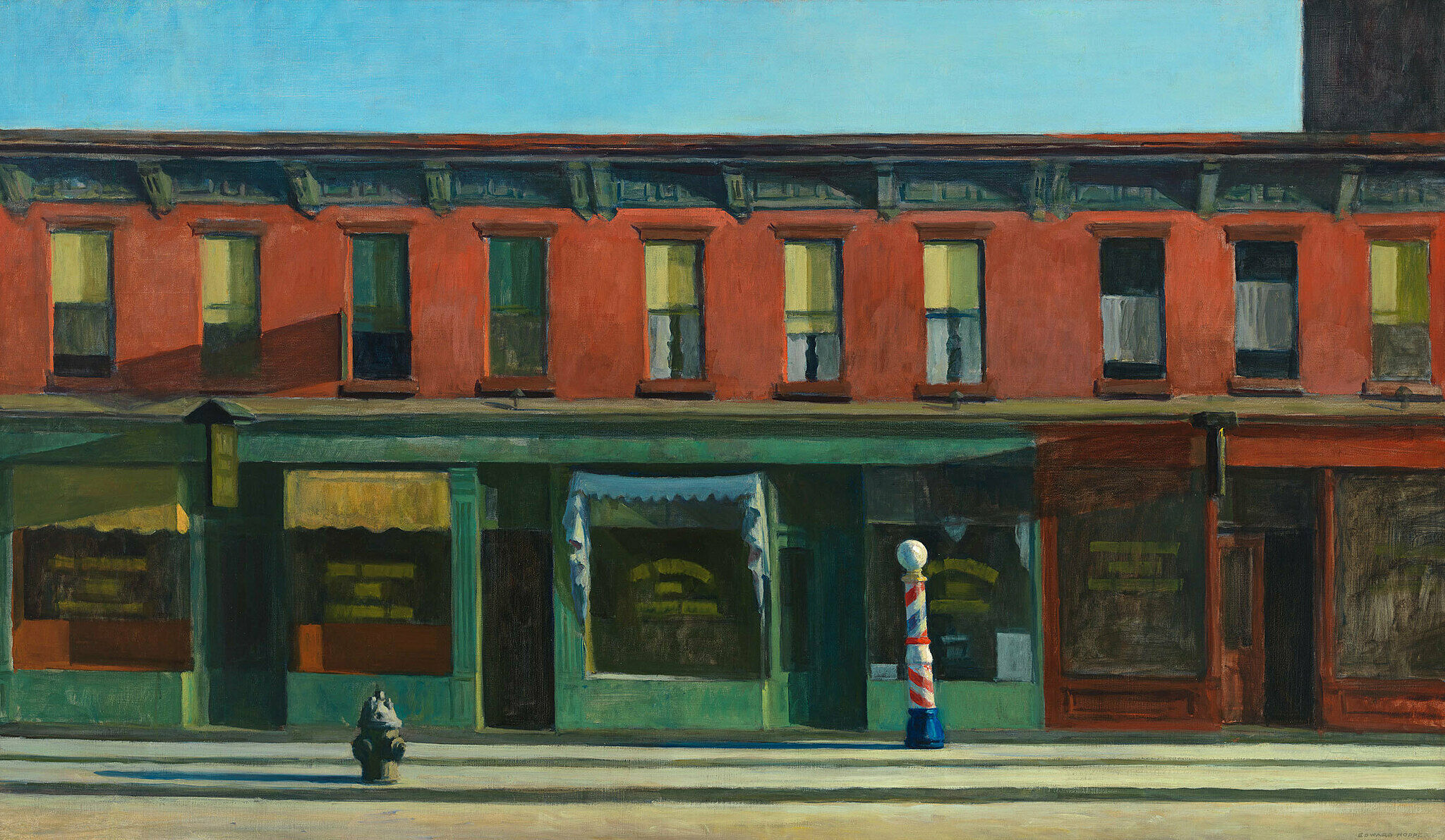
The Whitney’s Collection: Selections from 1900 to 1965
June 28, 2019–May 1, 2025
-
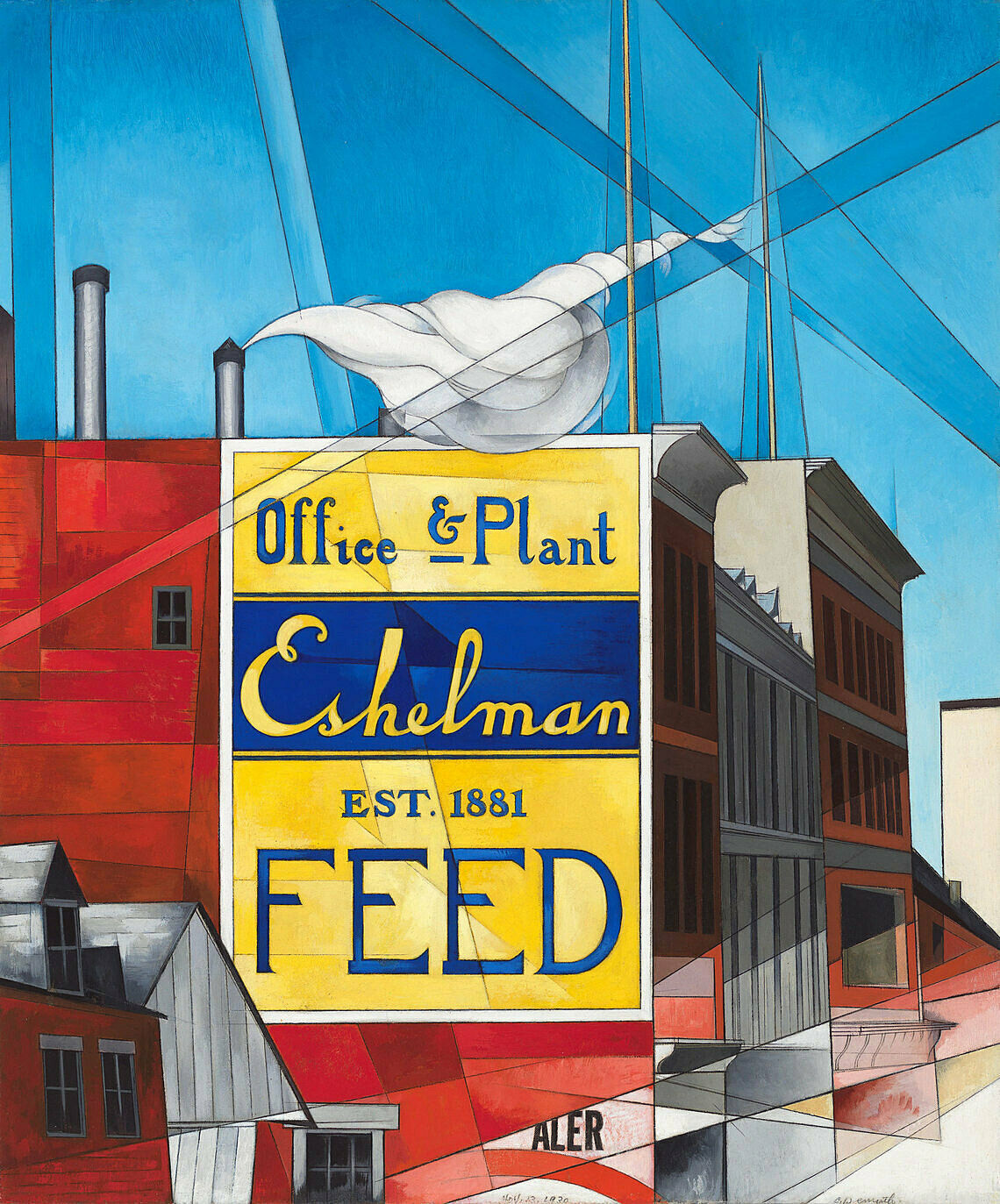
Where We Are: Selections from the Whitney’s Collection, 1900–1960
Apr 28, 2017–June 2, 2019
-
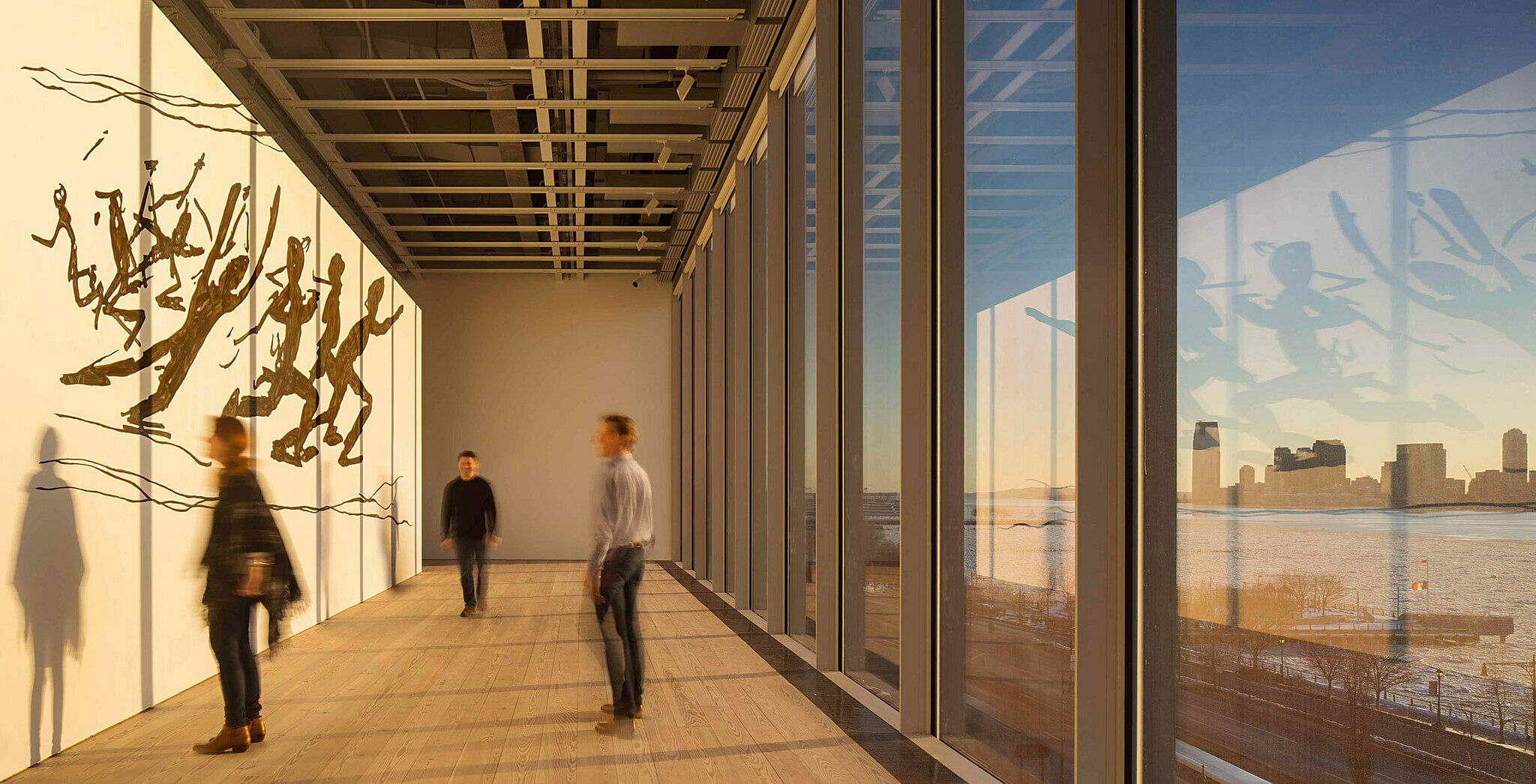
America Is Hard to See
May 1–Sept 27, 2015
-
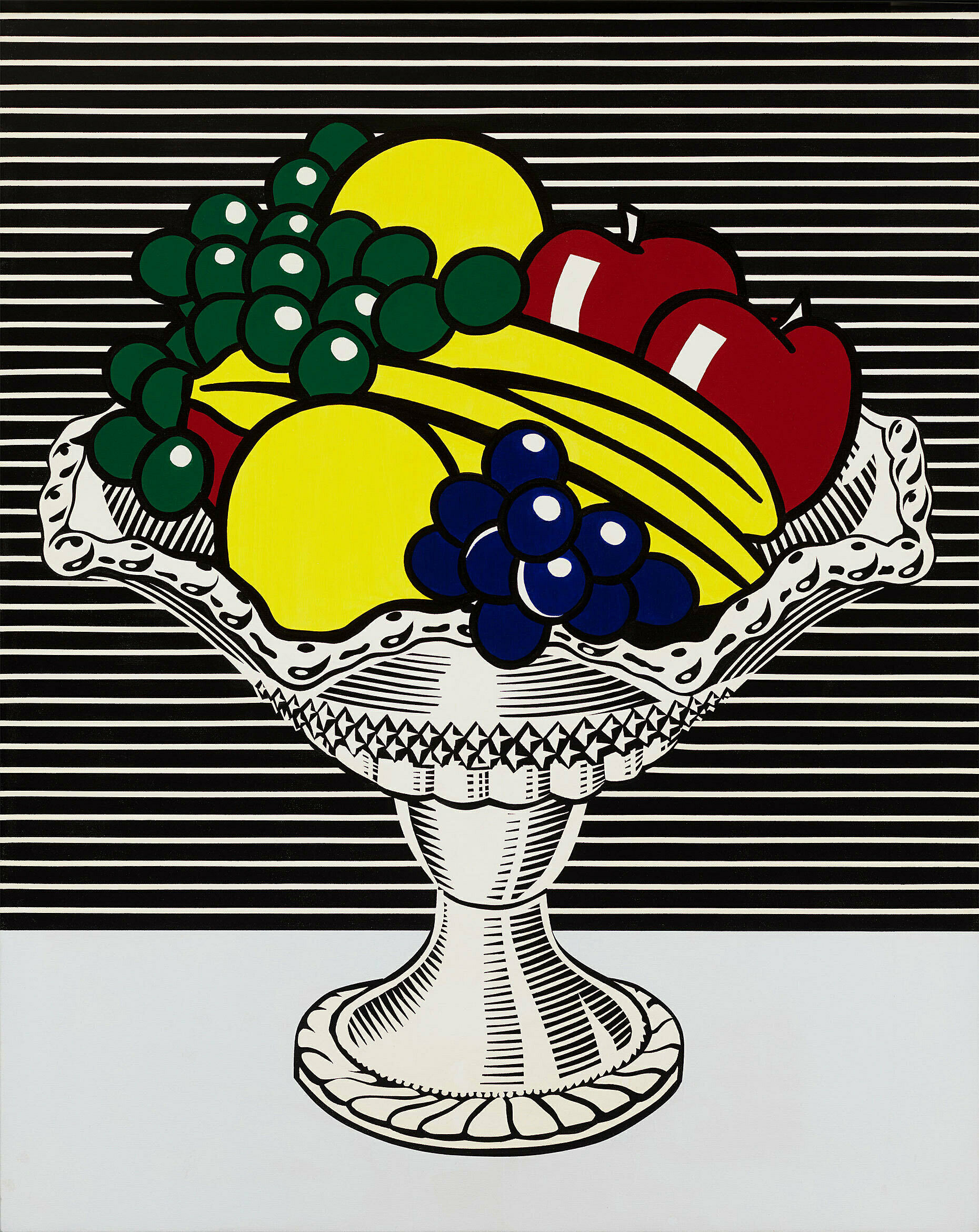
American Legends: From Calder to O’Keeffe
Dec 22, 2012–June 29, 2014
-
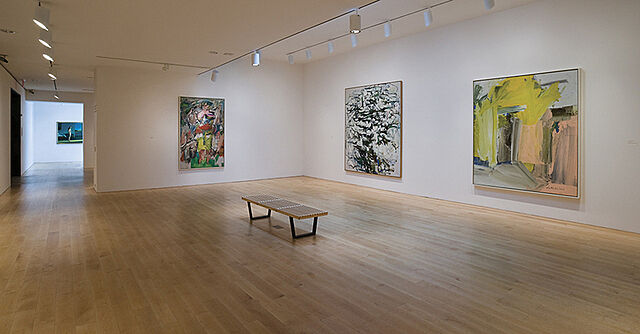
The Whitney’s Collection
Jan 30, 2008–Jan 3, 2010
-
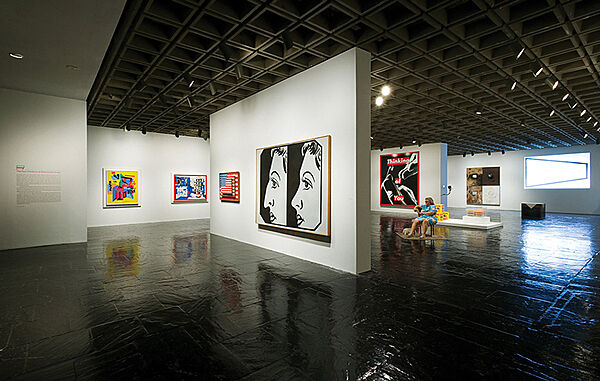
Full House: Views of the Whitney’s Collection at 75
June 29–Sept 3, 2006
-
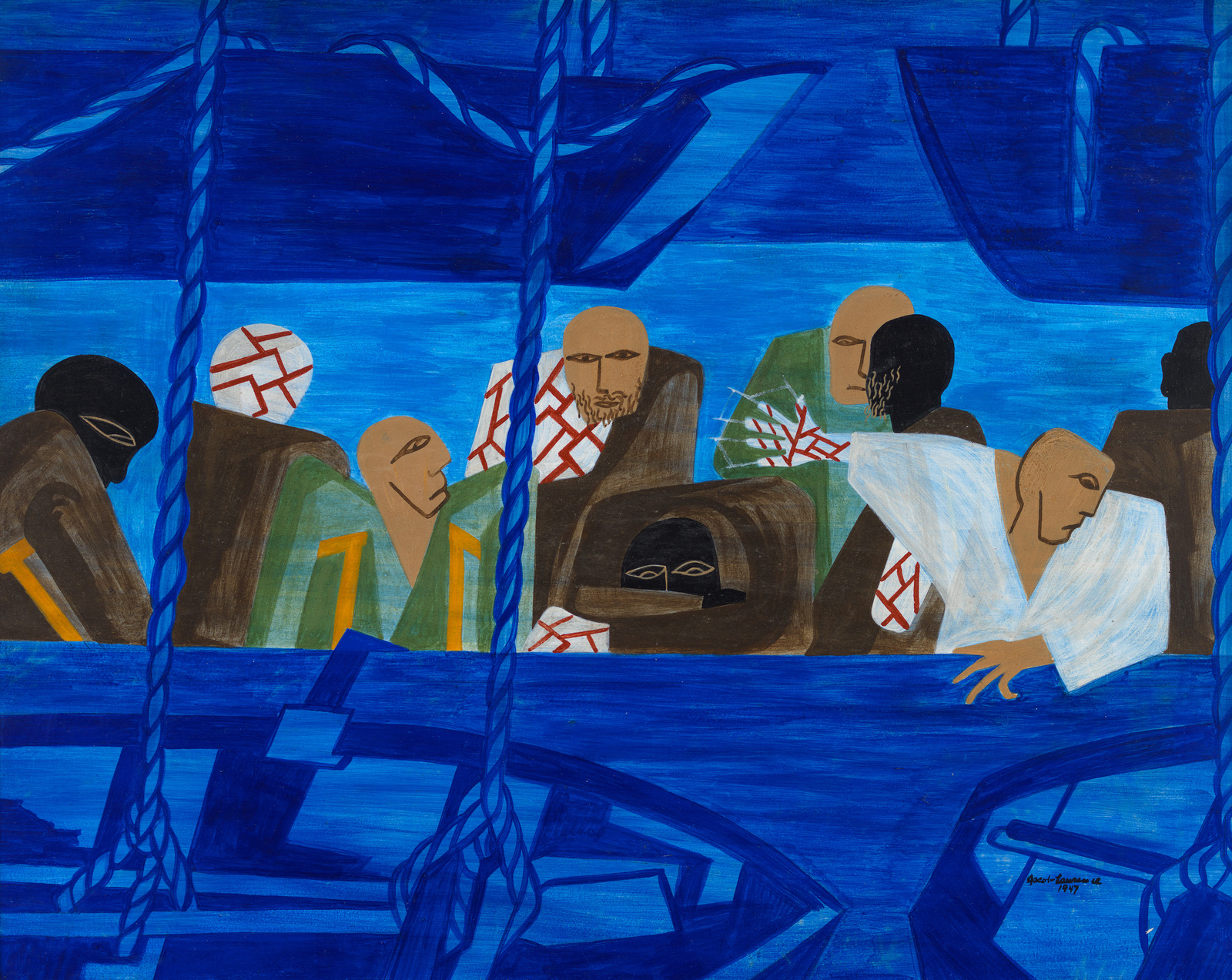
Over the Line: The Art and Life of Jacob Lawrence
May 25, 2001–Jan 30, 2003
Installation photography
-
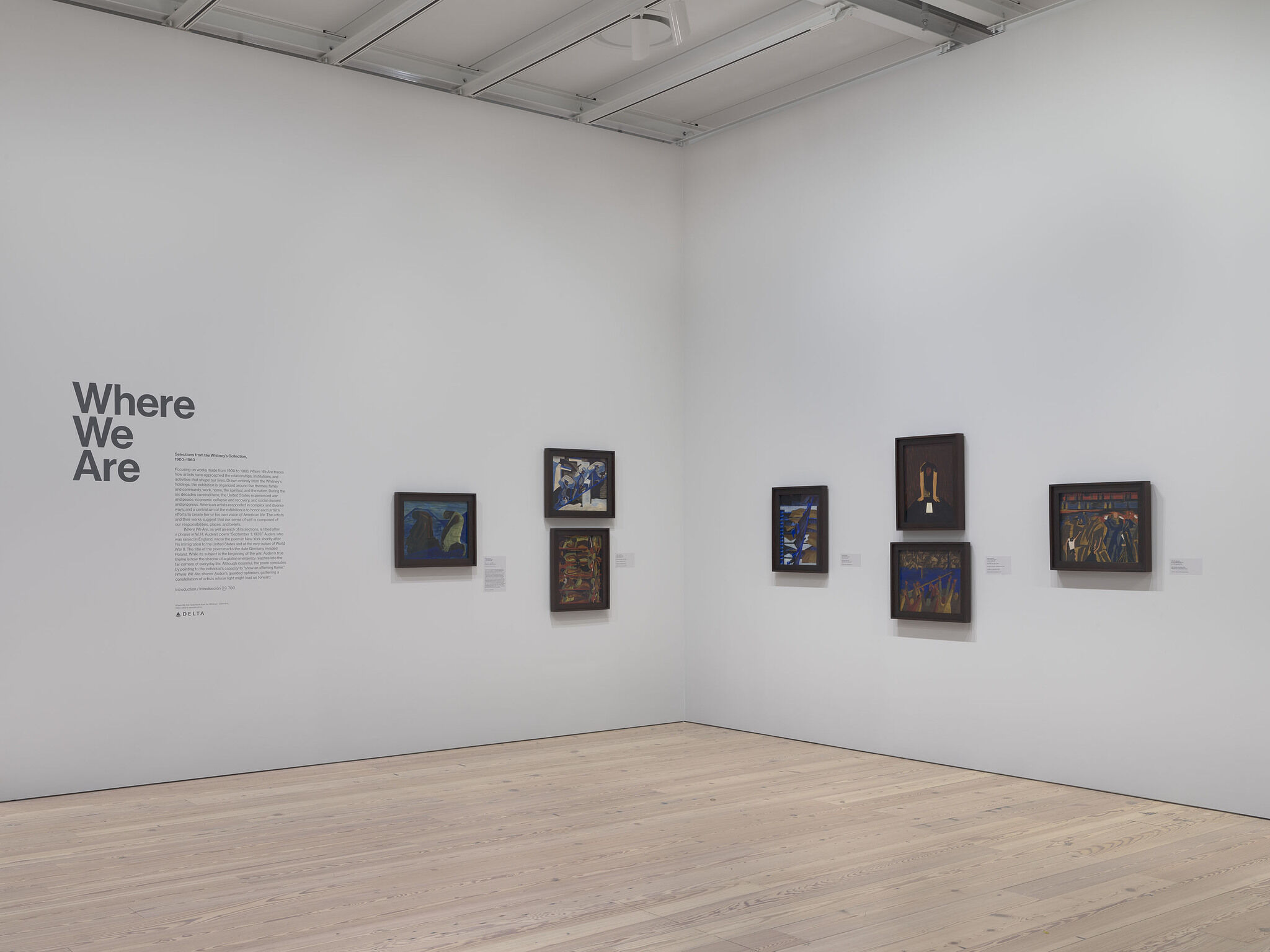

Installation view of Where We Are: Selections from the Whitney’s Collection, 1900–1960 (Whitney Museum of American Art, New York, April 28, 2017–June 2, 2019). From left to right, top to bottom: Jacob Lawrence, War Series: Prayer, 1947; Jacob Lawrence, War Series: Another Patrol, 1946; Jacob Lawrence, War Series: Shipping Out, 1947; Jacob Lawrence, War Series: Alert, 1947; Jacob Lawrence; War Series: The Letter, 1946; Jacob Lawrence, War Series: Docking – Cigarette, Joe?, 1947; Jacob Lawrence, War Series: On Leave, 1947. Photograph by Ron Amstutz
From the exhibition Where We Are: Selections from the Whitney’s Collection, 1900–1960

